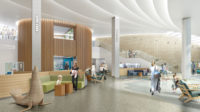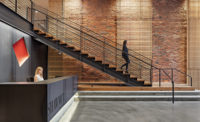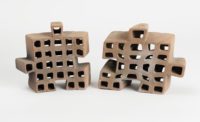Over the last 15 to 20 years, the combined energies of students, faculty, and administrators have broadened the focus on sustainability at U.S. colleges and universities to encompass a wide spectrum of concerns. From a start in recycling, raising awareness, and environmental-studies programs, the higher education’s sector’s green endeavors have burgeoned to include curriculum and research, planning and administration, and the many facets of campus operations.
Almost 4,000 higher-education projects have been LEED certified, with the majority achieving Gold or better. More than 650 college and university presidents from all 50 states have pledged their institutions will achieve carbon neutrality under the Climate Leadership Commitments, and nearly 800 colleges and universities are measuring their comprehensive environmental performance under STARS (Sustainability Tracking Assessment Rating System), a program of the Association for the Advancement of Sustainability in Higher Education. “Sustainable design is now fully ingrained and practiced on nearly every campus,” says Mike Moss, president of the Society for College and University Planning. “It’s a given topic of discussion on facility projects, and people are looking for the next level.”
Three projects profiled here exemplify that next level: a new campus designed for sustainability from first principles, an academic building now proving itself under the Living Building Challenge, and a campus residence that takes the Passive House standard to new heights. Impressive as these projects are, their significance isn’t entirely based on their technological innovations or how much energy, water, or other resources they conserve, says David Goldberg, a partner with the Seattle- and San Francisco–based design firm, Mithun. “The really big impact comes from the thousands of students, faculty, and visitors who take their lessons out into the world.”
Goldberg’s firm is architect and landscape architect for Chatham University’s Eden Hall Campus, one of the first in North America designed for sustainability from the ground up. Home to the Falk School of Sustainability, Eden Hall sits on almost 400 acres of farmland in a rapidly developing county 25 miles north of the university’s main campus in Pittsburgh. This location presented the project with its first challenge: how to reconcile a greenfield development with the core mission of a school of sustainability.
For its answer, Chatham is making the campus into a highly productive peri-urban landscape as an alternative to sprawl. Eden Hall’s site development, including an amphitheater, native plantings, a greenhouse, and a constructed wetland, are all designed in compliance with the Sustainable Sites Initiative. Its buildings (a field lab, a café, a dining commons, housing, an auditorium, classrooms, and offices) are targeting LEED Platinum certification at a minimum. The first phase of construction, which focused on the core of the campus and was completed last year, has a predicted net energy surplus of 10 percent.
With full-cycle water reclamation, net-positive energy production, and zero-waste operations, Eden Hall grows food and recycles nutrients, supports habitat and healthy soils, and fosters eco-literacy. “We can’t create sustainability in urban areas alone,” says Sandy Mendler, a principal with Mithun. “A net productive landscape complementing the city it borders offers a strategy for deep sustainability.”
An aesthetic of refined functionality with simple volumes clad in metal and wood supports the hands-on program. An awareness of the interrelatedness of systems permeates the design with architectural elements serving multiple purposes. For example, a long stretch of canopy at the campus entrance supports a photovoltaic array, catches rainwater for irrigation, provides shelter to students waiting for a bus, and defines the edge of an outdoor space. Campus gates of weathering steel are art pieces patterned with perforations representing data derived from the geology and hydrology of the site. And, as part of a perimeter fence, they prevent deer from eating the crops.
Among the opportunities of designing a campus from first principles lie a few challenges. One of these is the phasing of infrastructure development: on the one hand, there’s the efficiency of developing energy and water systems for an entire campus all in one go; on the other, there’s the up-front cost of investing in capacity that won’t be used for years. In the case of Eden Hall’s geothermal wells, which provide heating and cooling energy for the buildings, their modularity meant that capacity could be easily added over time. So the geothermal field is sized for the first phase of construction, with associated mechanical equipment, housed in the dining commons, sized for future capacity.
The wetland, which provides on-site wastewater treatment, is scaled for what the local regulators deemed necessary for the first phase only. But because the officials took a cautious approach with the unfamiliar technology, the resulting wetland is larger than what Mithun believes is necessary by a factor of three or four. The university hopes through careful monitoring and record-keeping to demonstrate that additional capacity will not be needed with future phases of construction.
The chance to design district-scale sustainability from scratch is a rare thing; more often, smaller opportunities arise piecemeal. In the higher-education sector, however, even a single building can have far-reaching impact. In constructing a new welcome center with administrative offices, a social hub, and classrooms at its campus entrance, Hampshire College, a liberal arts school in Amherst, Massachusetts, perceived a fit between its
institutional values and an ambitious environmental effort. The college’s recently completed R.W. Kern Center, designed by Cambridge, Massachusetts–based Bruner/Cott, is built to meet the Living Building Challenge (LBC) and has just embarked on the operational tracking year required for certification.
Widely considered the built environment’s most rigorous performance standard, LBC consists of seven performance categories, called petals: place, water, energy, health and happiness, materials, equity, and beauty. These are subdivided into a total of 20 imperatives, or obligatory criteria, each of which focuses on a particular aspect of creating a project in harmony with nature.
From rooftop solar arrays to a basement compost system, the 17,000-square-foot Kern Center’s orientation, form, mechanical systems, envelope, and landscaping all address the need to perform at net-positive energy and water. In fact, the building is projected to generate 25 percent more energy than it uses. But if advanced green buildings “just end up being science experiments,” says Jason Forney, Bruner/Cott principal, “they won’t succeed in introducing a new era.”
Instead, Kern integrates its building systems into architecture that makes human scale and experience the priority and emphasizes biophilic principles. To ground the building visually, concrete bands in the stone cladding grow thicker as they descend, creating the impression of a firmly rooted mass. A double-height glazed volume provides a central focal point to orient users. A narrow footprint, with glazing on opposite sides and framed views of the surroundings, creates a sense of the outdoors flowing through the interior. The solar-optimized form and materials from the bioregion provide a tangible connection to place.
The use of local materials, including regional stone and wood, and doors and cabinets salvaged from a nearby hospital, also proved an important strategy in meeting the LBC’s materials imperatives. These criteria, which many project teams consider the standard’s most challenging aspect, include a Red List of hazardous substances to avoid, requirements for responsible sourcing, and a set distance from the building site within which products must be obtained. Although the architects initially worried about assembling a materials palette that met all of the criteria, they learned “that it’s very possible to source the materials for this high level of sustainability in a local economy,” says Forney.
As a result of the project’s achievements, students report going out of their way to spend time in the building. They say it makes them feel calm, quiet, and connected. Apparently the construction workers felt it too: Kern was the only project the superintendent had seen in 30 years where the trades preferred to eat lunch inside.
Even before the building opened, students began using it in their curricula and project work. Partway into the 12-month performance-documentation period required for Living Building certification, Kern’s lessons are already reaching the larger world: with hands-on experience of the building’s rainwater-management system, a group of Hampshire undergrads entered a filtration project in the American Ecological Engineering Society’s design challenge and carried off first prize.
In addition to academic and administrative buildings, campus residences provide a less obvious but no less significant opportunity for universities and colleges to make sustainability memorable. At Cornell University’s new technology campus on New York’s Roosevelt Island, scheduled to open in the summer of 2017, 530 graduate students, faculty, and staff will come home to the world’s tallest—and, at 270,000 square feet, largest—Passive House. Designed by New York–based Handel Architects and known as the House, the 352-unit, 26-story tower will be North America’s first high-rise designed to this standard. (The campus is also to include a net zero academic building by Morphosis and a research and development hub by Weiss/Manfredi expected to achieve at least LEED Silver.)
Developed in Germany, the goal of Passive House is to drastically reduce energy consumption while improving occupant comfort. Based on absolute energy use rather than enhancement over code, Passive House permits a maximum heating energy of 4.75 kBtu/ft2/yr, a maximum cooling energy of 5.39 kBtu/ft2/yr, and a total building energy use intensity (EUI) of 38 kBtu/ft2/yr. Compared with the median EUI for New York buildings its size, the House is expected to reduce energy consumption by almost 75 percent.
The building relies on familiar passive design strategies, amplified to new levels. Its siting is optimized to maximize solar gains in the winter but minimize them during the summer. Its plan is a convex polygon that keeps the surface-to-volume ratio low, except at one corner. Here the polygon opens to create a reveal that houses louvers and extends up the full height of the building. It encloses an exterior space on each floor to accommodate condensing units for an energy-efficient variable refrigerant flow (VRF) system for heating and cooling. The louvered slot also allows the building to breathe: from there, filtered and tempered fresh air is supplied to each bedroom and living room (a radical innovation for a residential high-rise). The reveal also works architecturally, expressing the building enclosure as a wrapping.
To maintain a continuous blanket of insulation, eliminate thermal bridging, and reduce the number of joints needing to be sealed on-site against air infiltration, the project team designed custom curtain wall panels. Built off-site for improved quality control, the 9-foot-tall by 36-foot-long panels were delivered with triple-glazed windows pre-installed. The assembly is designed to achieve an overall R-value of 17 and a maximum air infiltration rate of 0.6 air changes per hour at 50 pascals of pressure. In order to achieve Passive House certification this infiltration rate must be confirmed with a blower door test once construction is complete.
The level of airtightness was a particular worry for team members due to the project’s unprecedented scale and the many conditions that could be prone to leaks, including the panel joints, fenestration, and building systems’ penetrations through the facade. So, in order to identify faulty joints before they were enclosed behind drywall and beyond reach, they devised a way to conduct preliminary blower door tests as well as a regimen for spot checks, explains Deborah Moelis, a senior associate at Handel.
Apart from the intensity of quality control, the biggest challenge in scaling Passive House up to a high-rise was the ventilation and exhaust system: adequate separation on individual units was impossible. Ventilation was solved through design, with the louvered reveal. But exhaust was solved through policy, pushing out another element on the green building frontier with a revision to New York City’s building code. Regulations now permit joining bathroom and kitchen exhausts as they discharge through the roof to facilitate the energy-saving strategy of heat recovery. This change in policy “was an exciting moment for the project,” says Moelis. It’s societal and regulatory changes like this, along with the innumerable people who will occupy and visit the Cornell project and other ultrasustainable campus buildings across the country, that make sustainability in the higher-education sector more than just an academic exercise.
|
Continuing Education

To earn one AIA learning unit (LU), including one hour of health, safety, and welfare (HSW) credit, read “Campuses Go Green,” review the supplemental material listed below, and complete the online test. Upon passing the test, you will receive a certificate of completion, and your credit will be automatically reported to the AIA. Additional information regarding credit-reporting and continuing-education requirements can be found online at continuingeducation.bnpmedia.com.
Supplemental Material AASHE STARS Technical Manual, Introduction
Living Building Challenge 3.0, Executive Summary
Learning Objectives 1 Describe how the sustainability movement on college campuses expanded in recent decades to include buildings and infrastructure. 2 Outline the requirements of green building certification systems such as Living Building Challenge and Passive House. 3 Discuss the strategy for sizing green infrastructure systems and phasing their installation at Chatham University’s Eden Hall Campus. 4 Discuss some of the design and construction challenges presented by the Cornell Tech residential tower, slated to be the world’s largest Passive House building.
AIA/CES Course #K1611
For CEU credit, read "Campuses Go Green" and take the quiz at continuingeducation.bnpmedia.com, or use our architectural record continuing-education app, available in the itunes store. structure, finishes, and other original fabric when
a building is moved.
significant buildings.
|













Post a comment to this article
Report Abusive Comment